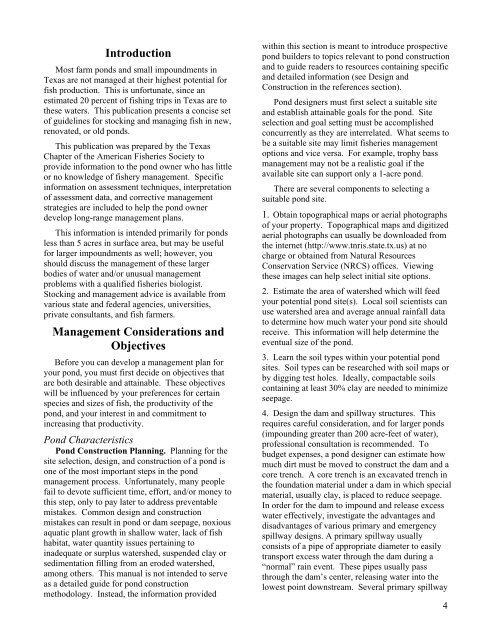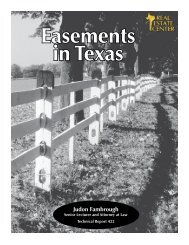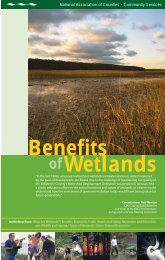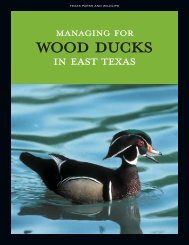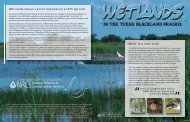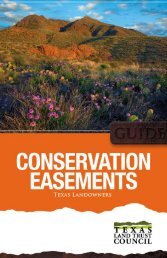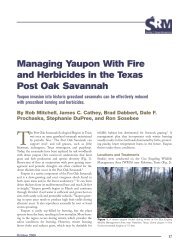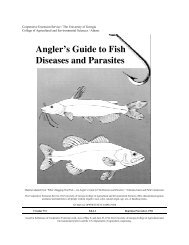Texas Farm Ponds: Stocking, Assessment, and Management ...
Texas Farm Ponds: Stocking, Assessment, and Management ...
Texas Farm Ponds: Stocking, Assessment, and Management ...
You also want an ePaper? Increase the reach of your titles
YUMPU automatically turns print PDFs into web optimized ePapers that Google loves.
Introduction<br />
Most farm ponds <strong>and</strong> small impoundments in<br />
<strong>Texas</strong> are not managed at their highest potential for<br />
fish production. This is unfortunate, since an<br />
estimated 20 percent of fishing trips in <strong>Texas</strong> are to<br />
these waters. This publication presents a concise set<br />
of guidelines for stocking <strong>and</strong> managing fish in new,<br />
renovated, or old ponds.<br />
This publication was prepared by the <strong>Texas</strong><br />
Chapter of the American Fisheries Society to<br />
provide information to the pond owner who has little<br />
or no knowledge of fishery management. Specific<br />
information on assessment techniques, interpretation<br />
of assessment data, <strong>and</strong> corrective management<br />
strategies are included to help the pond owner<br />
develop long-range management plans.<br />
This information is intended primarily for ponds<br />
less than 5 acres in surface area, but may be useful<br />
for larger impoundments as well; however, you<br />
should discuss the management of these larger<br />
bodies of water <strong>and</strong>/or unusual management<br />
problems with a qualified fisheries biologist.<br />
<strong>Stocking</strong> <strong>and</strong> management advice is available from<br />
various state <strong>and</strong> federal agencies, universities,<br />
private consultants, <strong>and</strong> fish farmers.<br />
<strong>Management</strong> Considerations <strong>and</strong><br />
Objectives<br />
Before you can develop a management plan for<br />
your pond, you must first decide on objectives that<br />
are both desirable <strong>and</strong> attainable. These objectives<br />
will be influenced by your preferences for certain<br />
species <strong>and</strong> sizes of fish, the productivity of the<br />
pond, <strong>and</strong> your interest in <strong>and</strong> commitment to<br />
increasing that productivity.<br />
Pond Characteristics<br />
Pond Construction Planning. Planning for the<br />
site selection, design, <strong>and</strong> construction of a pond is<br />
one of the most important steps in the pond<br />
management process. Unfortunately, many people<br />
fail to devote sufficient time, effort, <strong>and</strong>/or money to<br />
this step, only to pay later to address preventable<br />
mistakes. Common design <strong>and</strong> construction<br />
mistakes can result in pond or dam seepage, noxious<br />
aquatic plant growth in shallow water, lack of fish<br />
habitat, water quantity issues pertaining to<br />
inadequate or surplus watershed, suspended clay or<br />
sedimentation filling from an eroded watershed,<br />
among others. This manual is not intended to serve<br />
as a detailed guide for pond construction<br />
methodology. Instead, the information provided<br />
within this section is meant to introduce prospective<br />
pond builders to topics relevant to pond construction<br />
<strong>and</strong> to guide readers to resources containing specific<br />
<strong>and</strong> detailed information (see Design <strong>and</strong><br />
Construction in the references section).<br />
Pond designers must first select a suitable site<br />
<strong>and</strong> establish attainable goals for the pond. Site<br />
selection <strong>and</strong> goal setting must be accomplished<br />
concurrently as they are interrelated. What seems to<br />
be a suitable site may limit fisheries management<br />
options <strong>and</strong> vice versa. For example, trophy bass<br />
management may not be a realistic goal if the<br />
available site can support only a 1-acre pond.<br />
There are several components to selecting a<br />
suitable pond site.<br />
1. Obtain topographical maps or aerial photographs<br />
of your property. Topographical maps <strong>and</strong> digitized<br />
aerial photographs can usually be downloaded from<br />
the internet (http://www.tnris.state.tx.us) at no<br />
charge or obtained from Natural Resources<br />
Conservation Service (NRCS) offices. Viewing<br />
these images can help select initial site options.<br />
2. Estimate the area of watershed which will feed<br />
your potential pond site(s). Local soil scientists can<br />
use watershed area <strong>and</strong> average annual rainfall data<br />
to determine how much water your pond site should<br />
receive. This information will help determine the<br />
eventual size of the pond.<br />
3. Learn the soil types within your potential pond<br />
sites. Soil types can be researched with soil maps or<br />
by digging test holes. Ideally, compactable soils<br />
containing at least 30% clay are needed to minimize<br />
seepage.<br />
4. Design the dam <strong>and</strong> spillway structures. This<br />
requires careful consideration, <strong>and</strong> for larger ponds<br />
(impounding greater than 200 acre-feet of water),<br />
professional consultation is recommended. To<br />
budget expenses, a pond designer can estimate how<br />
much dirt must be moved to construct the dam <strong>and</strong> a<br />
core trench. A core trench is an excavated trench in<br />
the foundation material under a dam in which special<br />
material, usually clay, is placed to reduce seepage.<br />
In order for the dam to impound <strong>and</strong> release excess<br />
water effectively, investigate the advantages <strong>and</strong><br />
disadvantages of various primary <strong>and</strong> emergency<br />
spillway designs. A primary spillway usually<br />
consists of a pipe of appropriate diameter to easily<br />
transport excess water through the dam during a<br />
“normal” rain event. These pipes usually pass<br />
through the dam’s center, releasing water into the<br />
lowest point downstream. Several primary spillway<br />
4


